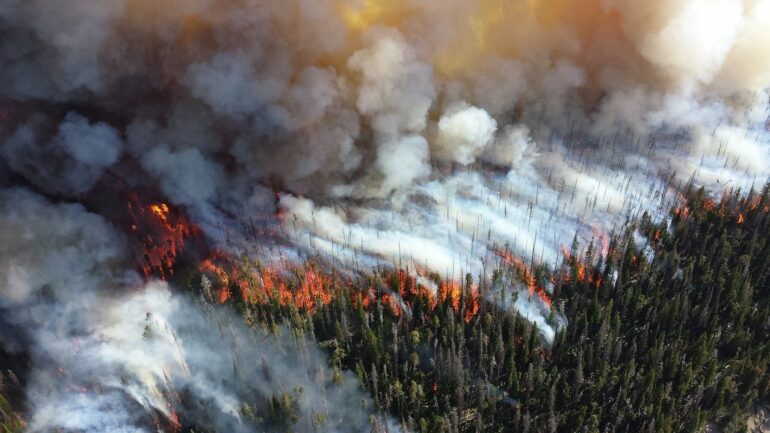Using data gathered from a specially equipped jet that spent a month flying through and studying wildfire plumes, scientists have a better understanding now of how wildfire smoke impacts air quality.
Crucially, they found a mechanism for predicting the production of the pollutant ozone—which, at the ground level, can create poor breathing conditions and also harm ecosystems. Also, the team found that mixing wildfire smoke with urban pollution ramps up the production of ozone, meaning that wildfires upwind of cities are a recipe for air quality problems.
“Of course it is well known that wildfires lower air quality. But it’s important to understand the chemical and physical mechanisms by which they do so that we can more effectively forecast how individual fires will impact the communities downwind of them,” says Paul O. Wennberg, R. Stanton Avery Professor of Atmospheric Chemistry and Environmental Science and Engineering.
Wennberg is a corresponding author of a paper on the research that was published by Science Advances on December 8.
The paper draws on data collected through the NASA/NOAA FIREX-AQ project, which spent a month flying missions out of Boise, Idaho, during the summer of 2019. (The project later studied agricultural fires in the Midwest.) Riding a DC-8 that had been converted into a flying laboratory, scientists flew through smoke plumes and gathered information from instruments mounted on the plane. Included in the payload were two instruments from Caltech operated by chemistry graduate students Krystal Vasquez and Hannah Allen, staff scientist John Crounse, and lead author Lu Xu, who completed the work as a staff scientist in Wennberg’s lab and is now a research scientist with the Cooperative Institute for Research in Environmental Sciences (CIRES) at the University of Colorado Boulder working in NOAA’s Chemical Sciences Laboratory.
“Smoke is difficult to study,” says Xu. “The chemistry and mixing evolve at scales much smaller than the resolution typically available by remote sensing. Also, it is operationally difficult to sample even from aircraft given the lack of visibility and challenges with air traffic control. FIREX-AQ overcame most of these barriers with a very well-instrumented aircraft with flight planning that was highly coordinated with the local air traffic control and the incident control officials fighting the fires.”
The FIREX-AQ project collected unprecedently detailed information about the evolving chemistry in the wildfire plumes. This included key observations that explain the chemistry that produces ozone in these fire plumes. The findings from this analysis help researchers understand why fire plumes have widely diverse chemistry: just downwind of the fire, ozone production is vigorous, but the rate of its formation slows as the plume mixes with ambient air. Initially, the plume is primed with a chemical, nitrous acid (HONO, also written as HNO2), that once emitted into the atmosphere, is converted by sunlight to hydroxyl radical (OH) and nitric oxide (NO)—both key ingredients that drive the formation of ozone from volatile organic compounds (VOCs, which are products of the inefficient combustion of both wood and soil).
Xu, Wennberg, and their colleagues then pored over data and demonstrated that the production of ozonecould be predicted as a function the amount of HONO emitted from the fire, the amount of VOCs, and the amount of NO. As the fire plume runs out of NO and HONO, the chemistry slows to a standstill, but importantly the fuel for ozone formation—the VOCs—remains elevated. As such, when these fire plumes mix into urban atmospheres rich in nitric oxide—which is produced by fossil fuel combustion, for example, from cars and trucks—ozone formation will begin, again impacting the air quality of the city.
“Wildfires increase regional ozone across the western US during fire season. The episodic nature of wildfires can result in more severe impacts on areas in close proximity to wildfires, as we in the western U.S. frequently experienced in the past few years,” says Xu.
Next, the team plans to keep mining the FIREX-AQ data for additional insights. “There are a lot more discoveries about fire chemistry and air quality still to be found in the information gathered through this project,” Wennberg says.
The Science Advances paper is titled “Ozone chemistry in western U.S. wildfire plumes.” There are numerous co-authors from Caltech; NOAA; NASA; the National Institute of Aerospace, the University of Colorado, Boulder; Florida State University; Georgia Institute of Technology; the Universities Space Research Association; Colorado State University; the U.S. Naval Research Laboratory; the University of Oslo in Norway; the Universität Innsbruck in Austria; Yokohama City University in Japan; and the University of Montana.
More information:
Lu Xu et al, Ozone chemistry in western U.S. wildfire plumes, Science Advances (2021). DOI: 10.1126/sciadv.abl3648
Provided by
California Institute of Technology
Citation:
Scientists show how wildfire smoke increases ozone pollution (2021, December 8)


